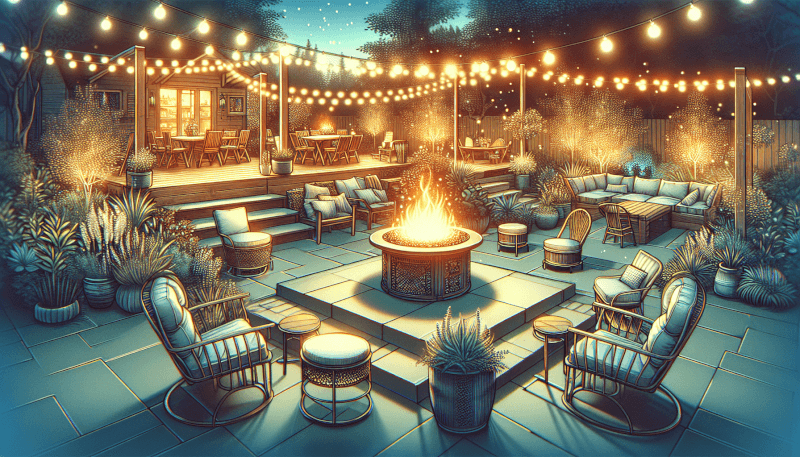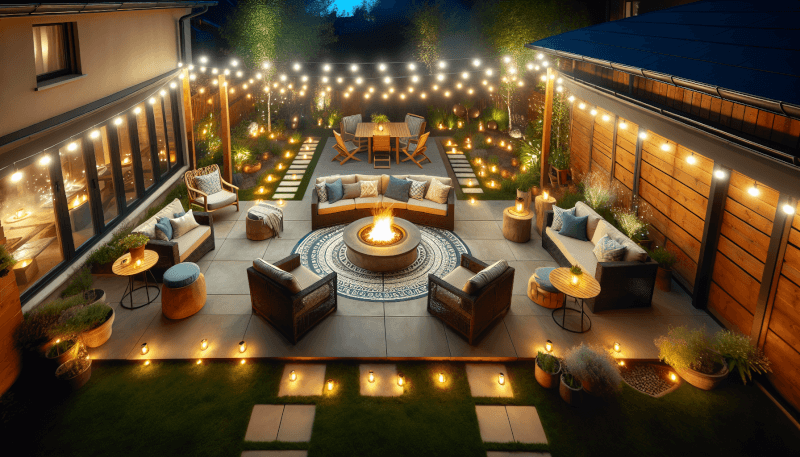Imagine transforming your backyard into a cozy oasis where you can gather with friends and family, surrounded by the warm glow of a crackling fire. In this article, we will explore the top ways to create your own DIY garden fire pit. From simple and budget-friendly options to more elaborate designs, we will guide you through the process of bringing this inviting and captivating feature to your outdoor space. Get ready to discover how to create a stunning fire pit that will enhance your evenings and make your backyard the envy of the neighborhood.

Choosing the Right Location
Consider Accessibility
When choosing the perfect location for your DIY fire pit, accessibility is key. You want to ensure that the fire pit is easily accessible for you and your guests. Consider placing it in an area that is easy to reach, away from obstacles and hazards. This will allow everyone to gather around the fire pit effortlessly and enjoy the warmth and ambiance it provides.
Check for Safety
Safety should be a top priority when selecting the location for your fire pit. Make sure to choose a spot that is a safe distance away from any flammable materials such as trees, shrubs, or buildings. Keep in mind that the area surrounding the fire pit should be clear of any debris or dry vegetation that could potentially catch fire. It is also important to check local regulations and guidelines to ensure that you are adhering to any specific fire safety requirements in your area.
Think about Aesthetic Appeal
In addition to functionality and safety, the aesthetic appeal of your fire pit’s location is also important. Consider a spot that offers a scenic view, whether it be your lush backyard, a picturesque garden, or a stunning landscape. Choosing a visually appealing location will not only enhance your overall outdoor space but will also create a cozy and inviting atmosphere for you and your guests to enjoy.
Deciding on the Type of Fire Pit
In-Ground Fire Pit
An in-ground fire pit is a classic option that provides a permanent fixture in your backyard. It is built by digging a hole in the ground and lining it with fireproof materials. This type of fire pit offers a rustic and natural look, blending seamlessly with the surrounding landscape. It requires more labor-intensive construction but provides a durable and long-lasting fire pit for your outdoor space.
Above-Ground Fire Pit
An above-ground fire pit is a popular choice for those who prefer a more portable option. It can be made using various materials such as bricks, stones, or metal. Above-ground fire pits are easier to construct and can be moved around your yard if desired. They offer versatility in terms of design and size, allowing you to customize the fire pit to fit your specific preferences and needs.
Portable Fire Pit
If flexibility and convenience are your main considerations, a portable fire pit is an excellent choice. These fire pits are lightweight and can be easily moved to different locations within your garden or even taken on camping trips. Portable fire pits are available in a wide range of designs, styles, and materials, making it easy to find one that suits your taste. They offer the added benefit of being easy to store when not in use.

Selecting the Materials
Bricks
Bricks are a timeless and durable material choice for building a fire pit. They provide a classic and traditional look while being resistant to high temperatures. Bricks can be stacked and arranged in various patterns, allowing for creative and unique designs. Additionally, they are readily available and relatively affordable, making them a practical choice for DIY fire pit enthusiasts.
Stone
Stone fire pits bring a touch of natural beauty to your outdoor space. They can be constructed using different types of stones such as flagstone, river rocks, or slate. Stones offer a rustic and earthy charm, blending seamlessly with your garden landscape. They are also highly heat-resistant and provide excellent insulation, ensuring a safe and efficient fire pit.
Concrete Blocks
Concrete blocks are a popular choice for DIY fire pit construction. They are versatile, affordable, and easy to work with. Concrete blocks come in various sizes and shapes, allowing you to create a fire pit that suits your preferences. They provide a sleek and modern look while offering excellent heat retention properties. With the right adhesive, they can be securely stacked to build a sturdy and durable fire pit.
Metal
Metal fire pits are another stylish and durable option. They are typically made from materials such as stainless steel or cast iron. Metal fire pits offer a contemporary and sleek appearance, perfect for modern outdoor spaces. They are known for their excellent heat distribution and can withstand high temperatures without warping or cracking. Metal fire pits are available in different sizes and styles, allowing you to find one that fits your aesthetic vision.
Preparing the Area
Clear the Space
Before starting the construction of your fire pit, it is important to clear the area of any vegetation, debris, and other obstructions. Ensure that there is enough space around the fire pit to provide a safe distance from other structures or flammable materials. Clearing the space will not only create a clean and safe environment but also prevent any potential fire hazards.
Level the Ground
To ensure stability and proper drainage for your fire pit, it is essential to level the ground. Use a shovel or a rake to remove any uneven or protruding areas. Leveling the ground will create a sturdy foundation for your fire pit and prevent it from shifting or sinking over time. This step is particularly important for in-ground fire pits as it ensures that the pit is properly aligned and positioned.
Add a Fireproof Layer
To protect the ground and surrounding area, it is recommended to add a fireproof layer before constructing the fire pit. This can be done by laying a layer of fire bricks, pavers, or gravel. The fireproof layer acts as a barrier, preventing the heat from damaging the ground directly. It also helps to distribute the heat evenly, ensuring that the ground beneath the fire pit remains safe and intact.

Designing the Layout
Mark the Dimensions
Before you begin digging or building, mark the dimensions of your fire pit layout. Use string, chalk, or marking paint to outline the shape and size of your desired fire pit. This will serve as a guide and ensure that your fire pit is constructed to the desired specifications.
Create a Circle or Square
Fire pits can be designed in various shapes, with circles and squares being the most common. Choose the shape that best complements your outdoor space and aligns with your overall design aesthetic. If opting for a circular fire pit, consider using a stake and string to help create a perfect circle outline. For a square fire pit, use a measuring tape and stakes to mark the four corners and connect them with string or marking paint.
Add Seating Area
To enhance the overall functionality of your fire pit, consider adding a seating area around it. This can be done by placing outdoor furniture, such as chairs, benches, or built-in seating, in close proximity to the fire pit. Adding seating will ensure that you and your guests have a comfortable and cozy space to gather, relax, and enjoy the warmth of the fire.
Digging the Pit
Dig the Hole
For in-ground fire pits, dig a hole according to the dimensions you marked earlier. Use a shovel or a digging tool to excavate the soil, ensuring the hole is deep enough to accommodate the fire pit and allow for proper airflow. The depth will depend on the size and design of your fire pit, but a general rule of thumb is to dig the hole at least 12-18 inches deep.
Remove Excess Dirt
Once the hole has been dug, remove any excess dirt or debris from the area. This will provide a clean and level surface for constructing the fire pit. You can use a wheelbarrow or buckets to transport the excess dirt away from the pit site.
Create a Base
To ensure stability and proper drainage for your in-ground fire pit, create a base at the bottom of the hole. This can be done by adding a layer of gravel or sand. The base will help to level the bottom of the pit and provide a solid foundation for the fireproof materials that will be laid.

Building the Fire Pit
Lay the First Layer of Bricks/Blocks
Start by laying the first layer of bricks or blocks around the perimeter of the fire pit. This will establish the shape and size of your fire pit. Ensure that the bricks or blocks are tightly placed and level, using a spirit level to check for accuracy. This first layer will serve as the foundation for the rest of the construction.
Continue Building Layers
Once the first layer is in place, continue building subsequent layers by stacking the bricks or blocks on top. The number of layers will depend on the desired height of your fire pit. As you stack, make adjustments to ensure that each layer is level and securely in place. Take your time and pay attention to detail, as a well-built fire pit will provide years of enjoyment.
Use a Fireproof Adhesive if Needed
If using bricks or blocks that don’t interlock naturally, or if additional stability is desired, consider using a fireproof adhesive to secure the layers together. This will add an extra level of durability to your fire pit construction. Apply the adhesive between each layer, following the manufacturer’s instructions for proper usage.
Adding a Gravel Base
Layer Gravel at the Bottom
For above-ground and portable fire pits, it is recommended to add a layer of gravel at the bottom. This helps with drainage and acts as a protective barrier between the fire and the ground. Spread a layer of gravel evenly at the bottom of the fire pit, ensuring it covers the entire area.
Smooth and Level the Gravel
Once the gravel is in place, use a rake or shovel to smooth and level it. This will create a stable and even surface for placing the fire pit. Ensure that the gravel is evenly distributed and free from any large rocks or debris that may interfere with the placement of the fire pit.

Setting the Fire Pit
Place the Fire Pit in Position
Carefully position the fire pit in the designated location, whether it’s the in-ground pit or the above-ground structure. Make sure it is centered and aligned with the surrounding seating area or desired focal point. Take your time to ensure that it is set securely, with all sides and edges properly supported.
Check for Stability
Once the fire pit is in place, check for stability. Give it a gentle shake or push to ensure that it doesn’t wobble or move. If any adjustments are needed, make them before proceeding. A stable fire pit will provide a safe and enjoyable experience for everyone.
Adding Finishing Touches
Decorate the Surroundings
To enhance the overall ambiance of your fire pit area, consider adding decorative elements to the surroundings. This can be done by placing potted plants, outdoor lighting, or decorative stones around the fire pit. Additionally, you can incorporate seating cushions or blankets to create a cozy and inviting atmosphere.
Consider Safety Features
To promote safety while enjoying your fire pit, consider installing safety features such as a fire pit screen or spark guard. These can help prevent sparks and embers from escaping the fire pit, reducing the risk of accidental fires. Additionally, keep a fire extinguisher or bucket of sand nearby in case of emergencies.
Add Fire Pit Accessories
To fully enjoy your fire pit experience, consider adding accessories such as a grill grate for cooking, a firewood storage rack, or even a fire pit cover to protect it from the elements. These accessories can enhance the functionality of your fire pit and make it more versatile for different uses.
In conclusion, creating a DIY garden fire pit involves careful consideration of the location, type, materials, preparation, layout, digging, and building. By following the steps outlined in this article, you can successfully construct a fire pit that suits your aesthetic preferences, meets safety requirements, and provides a warm and inviting space for relaxation and socializing in your garden.


